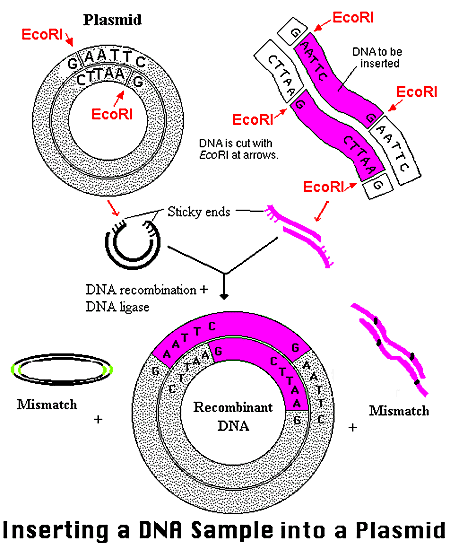|
|
|
..........plasmids as dna Vectors.........
Plasmids are similar to viruses, but lack a protein coat and cannot
move from cell to cell in the same fashion as a virus.
Plasmid vectors are small circular molecules of double stranded DNA
derived from natural plasmids that occur in bacterial cells. A piece of DNA can
be inserted into a plasmid if both the circular plasmid and the source of DNA
have recognition sites for the same restriction
endonuclease.
The plasmid and the foreign DNA are cut by this restriction endonuclease (EcoRI
in this example) producing intermediates with sticky and complementary ends.
Those two intermediates recombine by base-pairing and are linked by the action
of DNA ligase. A new plasmid containing the foreign DNA as an insert is
obtained. A few mismatches occur, producing an undesirable recombinant.
The new plasmid can be introduced into bacterial cells that can produce
many copies of the inserted DNA . This technique is called DNA
cloning.
the plasmids can replicate independently of the genome, and are found in
numbers ranging from one per cell to hundreds per cell (this is called
"copy number"). Plasmids frequently carry genes for antibiotic
resistance. While antibiotic resistance is becoming an increasingly important
problem medically, it is a useful marker in Recombinant DNA technology. Such
markers, along with the small size and potentially high copy number, make
plasmids indispensible tools in Molecular Biology. The following figure is an
example of a typical plasmid, called pACYC184, which is 4,240 base pairs (bp, or
4.24 kilobases, kb).
This
plasmid map has 3 marked regions on it. Two of them are antibiotic resistance
genes, one for Tetracycline resistance (Tc) and the other for
Chloramphenicol resistance (Cm). The arrows denote the direction the genes are
transcribed. Remember that transcription can only occur in the 5' --> 3'
direction, b
![[pACYC map]](http://kkk.gobot.com/plasmid.gif)
Plasmids are replicated by the same machinery that replicates the bacterial chromosome. Some plasmids are copied at about the same rate as the chromosome, so a single cell is apt to have only a single copy of the plasmid. Other plasmids are copied at a high rate and a single cell may have 50 or more of them.
Genes on plasmids with high numbers of copies are usually expressed at high levels. In nature, these genes often encode proteins (e.g., enzymes) that protect the bacterium from one or more antibiotics.
Plasmids enter the bacterial cell with relative ease. This occurs in nature and may account for the rapid spread of antibiotic resistance in hospitals and elsewhere. Plasmids can be deliberately introduced into bacteria in the laboratory transforming the cell with the incoming genes.

5' GGATCC 3'that, as we saw above, is cut by the restriction enzyme BamHI
3' CCTAGG 5'
5' AAGCTT 3'that is cut by the restriction enzyme HindIII
3' TTCGAA 5'
the images are selected from many sites in the web.